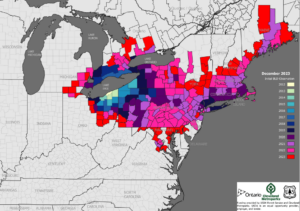
Beech leaf disease map by year through December 2023. It does not include current 2024 spread in Vermont, New Hampshire, New York and Maine.
Just months after beech leaf disease (BLD) was identified and confirmed at Legacy’s Creekshead Preserve in June of 2023, a team of scientists and students from the University of Michigan School for Environment and Sustainability (SEAS) took steps to incorporate the preserve into their research.
And although no evidence of BLD was found at Legacy’s Anthony and Rose Shatter Family Preserve, which is located less than a mile from Creekshead Preserve, it is also being monitored as part of the study.
The team, led by Dr. Stella Cousins, is gathering data to learn more about the natural history of BLD in order to determine new ways to slow its pathways and mitigate resulting mortality. Over the last year, they have been focused on detecting the extent and severity of the disease throughout Michigan as well as increasing public awareness.
In 2023, Dr. Cousins and her team expanded detection and monitoring efforts across southeast Michigan. They established 19 new long-term monitoring plots in beech stands–including Creekshead and Shatter Family Preserves–and conducted detailed surveys along more than 28 miles of trail in public parks and recreation areas.
The long-term plots are important laying the groundwork for understanding how forests affected by beech leaf disease change through time. Last year, most Michigan locations with BLD showed minor, sometimes barely detectable symptoms. Unfortunately, BLD is gaining ground quickly.
“During this year’s growing season, many locations where the percentage of leaf area affected was low in previous years have increased in extent and severity, and spread to additional trees nearby,” Dr. Cousins said. “At Creekshead, the percentage of leaf area affected was a bit elevated compared to last year, and some spread was seen within the stand. However, BLD has not affected all beech trees in the Preserve; many asymptomatic trees remain.”
According to a 2024 summary by Dr. Cousins in the Michigan Department of Natural Resources annual Forest Health Highlights:
BLD observations in the Eastern US and Canada during 2024 showed increasing range throughout northern New England, with more counties in Maine, Vermont, and New Hampshire discovering their first symptomatic trees. Occurrences have also increased throughout New York.
The expanding distribution of BLD into colder climates indicates that beech in northern Michigan and the Upper Peninsula are likely also at risk. Areas where BLD has persisted for 8-10 years are now showing mortality of not only small diameter trees, but larger canopy trees as well. The pace of mortality appears to vary with tree vigor, and long-term studies hope to detect resistant trees and understand survival trends in greater detail.
Researchers have also continued clarifying the life cycle and dispersal routes of Litylenchus crenatae mccannii. This introduced species is now understood to be the nematode that drives BLD’s characteristic banding, shriveling, and bud failure symptoms. It is most abundant in bud tissue, and in affected trees accumulates to high densities as buds form in the fall. Damage from Litylenchus causes disruption of the cellular organization of the bud and leaf and contributes to less efficient photosynthesis.
In 2023-2024, Michigan Department of Natural Resources and University of Michigan SEAS students also collaborated on a survey for the BLD nematode in unaffected beech forests, focusing on southern Michigan. They found no indication that the nematode was present in the 29 sites that were sampled.
Although, new BLD observations were not reported from any additional counties in Michigan during 2024, new occurrences have emerged in the southeast portion of the state, including in parks and recreational areas. The surveys and plot measurements found 10 previously unknown disease centers. Most of the newly reported forests show mild to moderate symptoms that suggest BLD has been present for a few years prior to being sighted.
There is a glimmer of good news from Legacy’s Shatter Preserve though. It is being surveyed regularly and shows no evidence of the disease yet.
With BLD on the rise in the region, arborists and land managers like Legacy’s Preserve Stewardship Manager Kyler Moran are relying on the information Dr. Cousins is gathering to help understand next steps and manage impacted trees.
“Shatter and Creekshead are excellent ecological examples of intact Mesic Southern Forest, a natural community which has become far less common as a result of anthropogenic disturbance over the last 150 years,” Moran said. “Beech leaf disease represents a massive threat to this already imperiled community, and Dr. Cousins’ research is integral in our regional understanding of its spread.”
What can you do?
Early detection is a key part of ongoing state and federal research and will be instrumental in understanding the factors that shape BLD’s rapid spread. Detecting BLD symptoms early also helps predict how forests may change and discover potential management options.
If you have beech trees on your property, monitor them regularly and look for any signs of symptoms.
Tips for spotting beech leaf disease
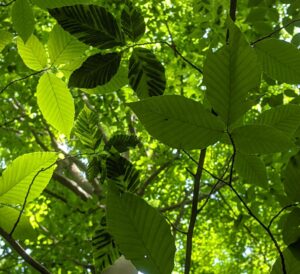
An infected beech tree at Creekshead Preserve. Notice the patchy coloration on the leaves, a strong indicator of Beech Leaf Disease.
Be prepared: Learn about typical BLD symptoms and less serious but similar-looking pests and diseases at www.Michigan.gov/invasives/id-report/disease/beech-leaf-disease
Start low: Small trees are often the most severely affected and first to show symptoms. This makes the backlit subcanopy leaves that are visible without binoculars a very good place to investigate first.
Symptoms change with the seasons: Damaged bands are dark at leaf-out, then turn brown and dry before healthy leaves do. They may drop off early. Bands are present at leaf emergence and beech leaf disease is easiest to discern from other forms of leaf damage, such as leaf rolling aphid, in the early summer.
Sanitation: Limit movement of beech wood, leaves and litter as much as possible, including movement of nursery stock. After visiting a site, thoroughly wash boots and equipment used, then spray with alcohol.
Reporting beech leaf disease
If you suspect your beech trees are affected, take one or more photos and make note of the location, date and time of the observation, and report to:
- DNR Forest Health Division: [email protected] or by phone at 517-284-5895.
- Or use the Midwest Invasive Species Information Network (MISIN) online reporting tool.
- Or download the MISIN smartphone app and report from your phone – MISIN.MSU.edu
More resources are available here:
- https://www.michigan.gov/invasives/id-report/disease/beech-leaf-disease
- https://www.clevelandmetroparks.com/parks/education/education-resources/publications
- University of Michigan graduate student Vincent Ader (R) (who works on BLD research with Dr. Cousins) explains the symptoms of infected trees to Creekshead visitors. Note the many tree branches surrounding them – this is the result of a BLD tree mortality event.
- Jenna Nutter (C), a student working on beech leaf disease research with Dr. Cousins, shares updates on the spread at Creekshead Preserve.

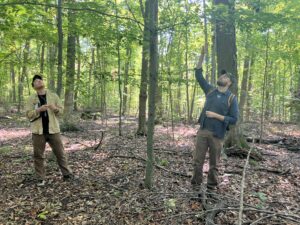
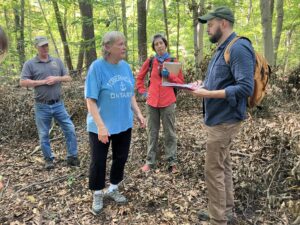
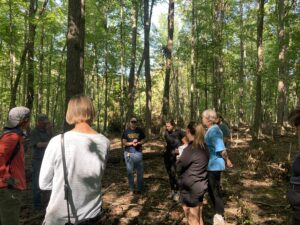
 RSS Feed
RSS Feed